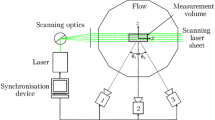Abstract
The performance of a purely digital evaluation system for photographic PIV recordings is described. High resolution digital images are obtained from the 35 mm negatives using a commonly available slide scanner. Together with the continually improving capabilities of standard computers, this evaluation system is a cost effective alternative to the traditional analog optical/digital (Young's fringe method) and purely optical PIV interrogation systems. Compared to the optical systems the fully digital evaluation can provide a higher spatial resolution while maintaining a similar measurement uncertainty. Using actual PIV recordings absolute measurement uncertainties are obtained and further predictions toward optimal displacement data recovery are made with the aid of Monte-Carlo simulations. Measurement uncertainties are minimized for particle image diameters on the order of 2 pixels while the reduction of the image depth (i.e. bits/pixel) has little effect. The overall performance of the described digital evaluation is compared to two types of optical evaluation systems.
Similar content being viewed by others
References
Adrian, R.J., Particle-imaging techniques for experimental fluid mechanics.Ann. Rev. Fluid Mech. 23 (1991) 261–304.
Adrian, R.J., Limiting resolution of particle image velocimetry for turbulent flow. In:Advances in Turbulence Research, Postech, Pohang, Korea, 27–29 March (1995) pp. 1–19.
Keane, R.D. and Adrian, R.J., Theory of cross-correlation analysis of PIV images.Appl. Sci. Res. 49 (1992) 191–215.
Keane, R.D., Adrian, R.J. and Zhang, Y., Super-resolution particle imaging velocimetry.Meas. Sci. Tech. 6 (1995) 754–768.
Meinhart, C.D., Prasad, A.K. and Adrian, R.J., A parallel digital processor system for particle image velocimetry.Meas. Sci. Tech. 4 (1993) 619–626.
Oppenheim, A.V. and Willsky, A.S.,Signals and Systems. Prentice-Hall Signal Processing Series. Englewood Cliffs, NJ: Prentice-Hall (1983) pp.203–205.
Prasad, A.K., Adrian, R.J., Landreth, C.C. and Offutt, P.W., Effect of resolution on the speed and accuracy of particle image velocimetry interrogation.Exps. Fluids 13 (1992) 105–116.
Press, W.H., Flannery, B.P., Teukolsky, S.A. and Vetterling, W.T.,Numerical Recipes in C. New York, NY: Cambridge University Press (1988) pp. 414–418.
Raffel, M., Leitl, B. and Kompenhans, J., Data validation for particle image velocimetry. In: R.J. Adrian et al. (eds.),Laser Techniques and Applications in Fluid Mechanics. Berlin: Springer-Verlag (1993) pp. 210–226.
Raffel, M. and Kompenhans, J., Error analysis for PIV recording utilizing image shifting. In:Proc. 7th Intl. Symp. on ‘Applications of Laser Techniques to Fluid Mechanics’, Lisbon, Portugal, 11–14 July (1994) pp. 35.5.1–35.5.5.
Raffel, M. and Kompenhans, J., Theoretical and experimental aspects of image shifting by means of a rotating mirror system for particle image velocimetry.Meas. Sci. Tech. 6 (1995) 795–808.
Raffel, M., Westerweel, J., Willert, C., Gharib, M. and Kompenhans, J., Analytical and experimental investigations of dual-plane PIV. In:SPIE Proc. Intl. Symp., Optical Science, Engineering, and Instrumentation, San Diego, U.S.A. 9–14 July 1995, SPIE Vol. 2546 (1995) pp. 75–86.
Vogt, A., Raffel, M. and Kompenhans, J., Comparison of optical and digital evaluation of photographic PIV recordings. In:Proc. 6th Intl. Symp. ‘Applications of Laser Techniques to Fluid Mechanics’, Lisbon, Portugal, 20–23 July (1992) pp. 27.4.1–27.4.6.
Vogt, A., Reichel, F. and Kompenhans, J., A compact and simple all optical evaluation method for PIV recordings. In:Proc. 7th Intl. Symp. on ‘Applications of Laser Techniques to Fluid Mechanics’, Lisbon, Portugal, 11–14 July (1994) pp. 35.2.1–35.2.8.
Wernet, M. and Pline, A., Particle displacement tracking technique and Cramer-Rao lower bound error in centroid estimates from CCD imagery.Exps. Fluids 15 (1993) 295–307.
Westerweel, J.,Digital Particle Image Velocimetry — Theory and Application. Delft: Delft University Press (1993).
Westerweel, J., Draad, A.A., van der Hoeven, J.G.Th. and van Oord, J., A fast data acquisition system for digital PIV. In:Proc. 7th Intl. Symp. on ‘Applications of Laser Techniques to Fluid Mechanics’, Lisbon, Portugal, 11–14 July (1994) pp 35.1.1–35.1.8.
Willert, C.E. and Gharib, M., Digital particle image velocimetry,Exps. Fluids 10 (1991) 181–193.
Author information
Authors and Affiliations
Additional information
Affiliated with DNW-NWB, DLR-Braunschweig.
Rights and permissions
About this article
Cite this article
Willert, C. The fully digital evaluation of photographic PIV recordings. Appl. Sci. Res. 56, 79–102 (1996). https://doi.org/10.1007/BF02249375
Received:
Issue Date:
DOI: https://doi.org/10.1007/BF02249375




